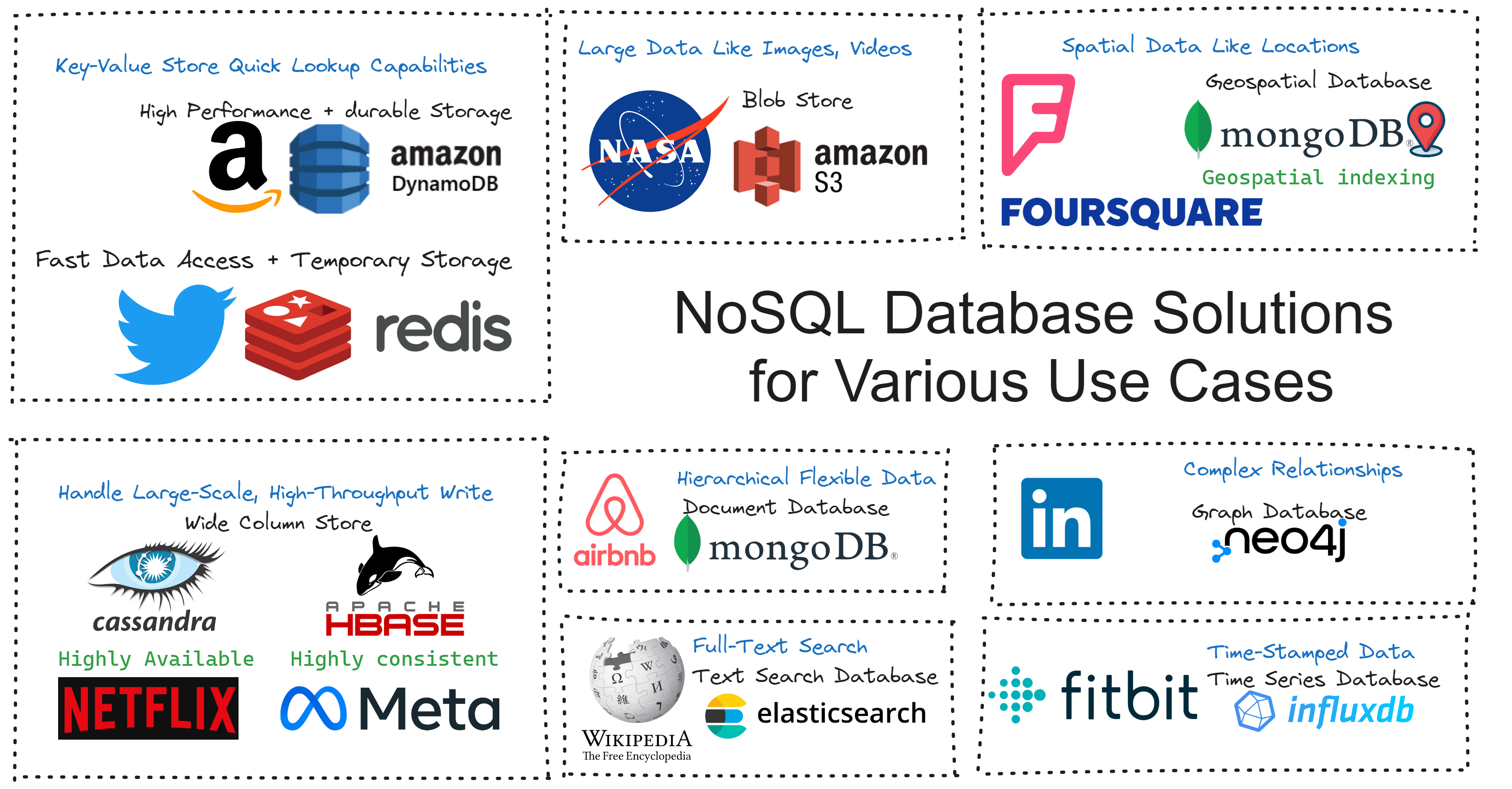Optimal NoSQL Database Solutions for Various Use Cases
 Divya Mahajan
Divya MahajanTable of contents
- 1. Storing Simple, Unstructured Data with Quick Lookup Capabilities
- 2. Handling Large-Scale, High-Throughput Write Operations and Storing Semi-Structured Data Across Many Columns
- 3. Storing, Retrieving, and Managing Hierarchical Data in a Flexible, Schema-Less Format
- 4. Managing and Querying Data with Complex Relationships and Interconnections
- 5. Storing and Serving Large Unstructured Data Like Images, Videos, and Other Multimedia Files
- 6. Storing and Querying Spatial Data Like Locations and Geographical Features
- 7. Enabling Full-Text Search on Large Volumes of Text Data
- 8. Storing and Analyzing Time-Stamped Data

1. Storing Simple, Unstructured Data with Quick Lookup Capabilities
a. High Performance with durable Storage
Use Case: Ideal for various applications, adeptly managing user profiles, product catalogs, session data, and more, requiring high availability, scalability, low-latency access, and flexible data modeling.
Example: Key-value stores facilitate swift read and write operations.
Recommended DB: Key-Value Store
Example DB: DynamoDB
Amazon DynamoDB: Employs for managing user session data and preferences in personalized shopping experiences on Amazon.com.
b. Extremely Fast Data Access and Temporary Storage
Use Case: Caching frequently accessed data such as session information or real-time analytics to minimize latency in web applications.
Example: In-memory stores ensure responses within sub-millisecond durations.
Recommended DB: In-Memory Store
Example DB: Redis, Memcached
Twitter uses Redis extensively for various purposes such as caching user timelines, storing temporary data, and managing real-time analytics.
2. Handling Large-Scale, High-Throughput Write Operations and Storing Semi-Structured Data Across Many Columns
- Recommended DB: Wide Column Store
a. High Availability
Use Case: Storing social media data necessitating high availability.
Example DB: Cassandra
Netflix: Utilizes Cassandra for managing extensive user data, preferences, and streaming history with robust availability.
b. High Consistency
Use Case: Storing clickstream data for subsequent analysis.
Example DB: HBase
Meta: Leverages HBase for storing vast amounts of data including user interactions, posts, and comments.
3. Storing, Retrieving, and Managing Hierarchical Data in a Flexible, Schema-Less Format
Use Case: E-commerce platforms requiring flexible management of products with varying attributes like size, color, and specifications.
Example: Document databases enable storage of nested objects and execution of complex queries.
Recommended DB: Document Database
Example DB: MongoDB, CouchDB
Airbnb: Utilizes MongoDB for managing listing data with diverse attributes including property details, pricing, and availability.
4. Managing and Querying Data with Complex Relationships and Interconnections
Use Case: Building social networking platforms where users are connected through various relationships.
Example: Graph databases efficiently model and query these relationships.
Recommended DB: Graph Database
Example DB: Neo4j, Amazon Neptune, ArangoDB
LinkedIn: Employs Neo4j to map intricate relationships between professionals, enabling features such as suggested connections and endorsements.
5. Storing and Serving Large Unstructured Data Like Images, Videos, and Other Multimedia Files
Use Case: Storing and retrieving user-uploaded media files, backups, or large datasets.
Example: Blob stores offer scalable and durable storage with easy access to binary large objects.
Recommended DB: Blob Store
Example DB: Amazon S3, Azure Blob Storage
Netflix: Uses Amazon S3 to store and serve vast amounts of multimedia content, including videos, images, and metadata.
6. Storing and Querying Spatial Data Like Locations and Geographical Features
Use Case: Applications involving location-based services, mapping, or asset tracking.
Example: Geospatial databases allow efficient querying and analysis using geographical coordinates.
Recommended DB: Geospatial Database
Example DB: PostGIS (extension of PostgreSQL), MongoDB with geospatial indexing
Uber: Utilizes PostGIS for managing and analyzing real-time location data of drivers and passengers for ride-hailing services.
Foursquare: Employs MongoDB with geospatial indexing for location-based recommendations and check-ins.
7. Enabling Full-Text Search on Large Volumes of Text Data
Use Case: Searching through document repositories, product catalogs, or web content requiring powerful text indexing and search capabilities.
Example: Text search databases provide fast and efficient querying.
Recommended DB: Text Search Database
Example DB: Elasticsearch, Solr
Wikipedia: Employs Elasticsearch for enabling rapid and efficient search across millions of articles and user-generated content.
8. Storing and Analyzing Time-Stamped Data
Use Case: Monitoring performance metrics, stock market data, or environmental sensor data where data points are associated with timestamps.
Example: Time series databases are optimized for such workloads.
Recommended DB: Time Series Database
Example DB: InfluxDB, TimescaleDB
Fitbit: Utilizes InfluxDB for storing and analyzing time-stamped sensor data, including fitness metrics and sleep tracking.
Coinbase: Employs TimescaleDB for storing and analyzing cryptocurrency market data with timestamps for trading and analytics.
Subscribe to my newsletter
Read articles from Divya Mahajan directly inside your inbox. Subscribe to the newsletter, and don't miss out.
Written by

Divya Mahajan
Divya Mahajan
Experienced Technical developer with 6+ years' global collaboration. Proficient in Python, Go, React, Next.js, Django, various databases, Cloud & DevOps (AWS EC2, Docker, Kubernetes), and Big Data tools. Skilled in data structures and algorithm, API development, and end-to-end software engineering. Excels in back-end development, front-end design, Root Cause Analysis, and product management to deliver superior user experiences. Holds a master’s degree in computer engineering.